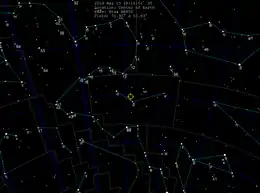HR 858
HR 858 is a star with a planetary system located 104[1] light years from the Sun in the southern constellation of Fornax. It has a yellow-white hue and is visible to the naked eye but is a challenge to see with an apparent visual magnitude of 6.4.[2] The star is drifting further away with a radial velocity of 10 km/s.[1] It has an absolute magnitude of +3.82.[5]
 Position of HR 858 in Fornax | |
| Observation data Epoch J2000.00 Equinox J2000.00 | |
|---|---|
| Constellation | Fornax |
| Right ascension | 02h 51m 56.246s[1] |
| Declination | −30° 48′ 52.26″[1] |
| Apparent magnitude (V) | 6.382[2] |
| Characteristics | |
| Evolutionary stage | F6V[3] + M[4] |
| Spectral type | Main sequence |
| B−V color index | +0.484[5] |
| Astrometry | |
| Radial velocity (Rv) | +10.07±0.13[1] km/s |
| Proper motion (μ) | RA: 123.229±0.070[1] mas/yr Dec.: 105.788±0.151[1] mas/yr |
| Parallax (π) | 31.2565 ± 0.0700 mas[1] |
| Distance | 104.3 ± 0.2 ly (31.99 ± 0.07 pc) |
| Absolute magnitude (MV) | +3.82[5] |
| Details[4] | |
| A | |
| Mass | 1.145+0.074 −0.080 M☉ |
| Radius | 1.310+0.0240 −022 R☉ |
| Luminosity | 2.348+0.069 −0.071 L☉ |
| Surface gravity (log g) | 4.19±0.10 cgs |
| Temperature | 6,201±50 K |
| Metallicity [Fe/H] | −0.14±0.08 dex |
| Rotational velocity (v sin i) | 8.3±0.5 km/s |
| Age | 2.28±1.30[6] Gyr |
| B | |
| Radius | 0.17±0.04 R☉ |
| Temperature | 2,800±300 K |
| Other designations | |
| Database references | |
| SIMBAD | data |
This object is a slightly-evolved F-type main-sequence star with a stellar classification of F6V,[3] which indicates it is generating energy through core hydrogen fusion. It is roughly two[6] billion years old and is spinning with a projected rotational velocity of 8.3 km/s. The star has 1.1 times the mass of the Sun and 1.3 times the Sun's radius. It is radiating 2.3 times the luminosity of the Sun from its photosphere at an effective temperature of 6,201 K.[4]
There is a faint co-moving stellar companion, designated component B, at an angular separation of 8.4″. This corresponds to a projected separation of 270 AU. It is most likely a red dwarf star.[4]
Planetary system
In May 2019, it was announced to have at least 3 exoplanets as observed by transit method of the Transiting Exoplanet Survey Satellite. All three are orbiting close to the host star and appear to be super-Earths, about twice the size of the Earth. Components 'b' and 'c' may be in a 3:5 mean motion resonance.[4]
| Companion (in order from star) |
Mass | Semimajor axis (AU) |
Orbital period (days) |
Eccentricity | Inclination | Radius |
|---|---|---|---|---|---|---|
| b | — | 0.0480+0.0010 −0.0011 |
3.58599±0.00015 | < 0.30 | — | 2.085+0.068 −0.064 R🜨 |
| c | — | 0.0674+0.0014 −0.0016 |
5.97293+0.00060 −0.00053 |
< 0.19 | — | 1.939+0.069 −0.069 R🜨 |
| d | — | 0.1027+0.0022 −0.0025 |
11.2300+0.0011 −0.0010 |
< 0.28 | — | 2.164+0.086 −0.083 R🜨 |
References
- Brown, A. G. A.; et al. (Gaia collaboration) (August 2018). "Gaia Data Release 2: Summary of the contents and survey properties". Astronomy & Astrophysics. 616. A1. arXiv:1804.09365. Bibcode:2018A&A...616A...1G. doi:10.1051/0004-6361/201833051. Gaia DR2 record for this source at VizieR.
- Høg, E.; et al. (March 2000). "The Tycho-2 catalogue of the 2.5 million brightest stars". Astronomy and Astrophysics. 355: L27–L30. Bibcode:2000A&A...355L..27H. doi:10.1888/0333750888/2862.
- Gray, R. O.; et al. (July 2006). "Contributions to the Nearby Stars (NStars) Project: spectroscopy of stars earlier than M0 within 40 pc-The Southern Sample". The Astronomical Journal. 132 (1): 161–170. arXiv:astro-ph/0603770. Bibcode:2006AJ....132..161G. doi:10.1086/504637. S2CID 119476992.
- Vanderburg, Andrew; et al. (2019). "TESS Spots a Compact System of Super-Earths around the Naked-Eye Star HR 858". The Astrophysical Journal. 881 (1): L19. arXiv:1905.05193. Bibcode:2019ApJ...881L..19V. doi:10.3847/2041-8213/ab322d. S2CID 153311715.
- Anderson, E.; Francis, Ch. (2012). "XHIP: An extended hipparcos compilation". Astronomy Letters. 38 (5): 331. arXiv:1108.4971. Bibcode:2012AstL...38..331A. doi:10.1134/S1063773712050015. S2CID 119257644.
- Pace, G. (March 2013). "Chromospheric activity as age indicator. An L-shaped chromospheric-activity versus age diagram". Astronomy & Astrophysics. 551: 4. arXiv:1301.5651. Bibcode:2013A&A...551L...8P. doi:10.1051/0004-6361/201220364. S2CID 56420519. L8.
- "HR 858". SIMBAD. Centre de données astronomiques de Strasbourg. Retrieved 2019-12-04.